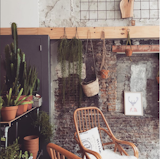This image shows how Brooks opened up interior, turning it into a light-filled space. While the home suggests a contemporary point of view, her inspiration for the interior actually came from medieval architecture and the great country homes of England. "The great halls where you'd have a feast had a ceremonial function as well as a domestic one. Here, the kitchen becomes a social hub, with the island as a hearth, in a way. The living room is the minstral's gallery, and the entertainent is on the mezzanine. With the double-height space in the center of the home, you encounter space in a different way." A Jasper Morrison Smithfield light hangs above the kitchen island. Brooks designed the kitchen cabinets and tables, as well as the steel fireplace.
The roughly 5,000-square-foot Lens House renovation, which was finished in 2012 and just won a 2014 RIBA National Award, required six years, major remedial work on the roof and walls, approval from the planning committee, and even a sign-off from a horticulturalist to guarantee the backyard excavation didn't interfere with a walnut tree. "These things aren’t for people who are in a hurry," says architect Alison Brooks. The focus is the ten-sided trapezoidal office addition. "It wraps itself around the house with a completely different set of rules than the Victorian building," she says.
The home's heat comes from a highly efficient wood-burning stove from Rais. Though wood burning is banned in Boulder, the sealed firebox can be used year-round, with combustion technology so effective it's said to release less carbon dioxide than decomposing wood. After logs burn down to embers, the stove continues to radiate heat for hours, reducing the amount of kindling required to keep the place warm.
In Boulder's aptly named Wonderland Hill neighborhood, deer and even mountain lions occasionally come down from the woods to scout the domestic scene, but the most common wildlife sighting on the tree-lined streets is a profusion of toddlers in off-road strollers. To make space for the local baby boom, many older one-story homes have had their pops topped. When Rob Pyatt and Heather Kahn were ready to expand on their 900 square feet, however, their foundation couldn't support a second floor, so Pyatt, an architecture student with a green building background, devised an alternative. His box-shaped addition is the modern kid on the block, with distinctive corrugated-metal and wide-plank cladding. Behind the facade, uncommon materials share a common story with the neighborhood: Of design decisions driven by a desire to keep the next generation—and the planet—healthy and safe.
In this Facade Focus on brick, Tom Verschueren, of Mechelen, Belgium-based DMVA Architects, created a closed street-side facade with an open backside facing the garden, totally glazed from the ground up to the saddleback roof. On the street side, the only true opening is the door; the seven tall, slim windows are screened by what Verschueren calls “knitted” bricks. “In this part of Belgium, 90 percent of the houses are built with brick,” says Verschueren. “It’s a classic material that we tried to use in House BVA in a totally different way.”
Tribeca Manufacturing Building
New York–based architect Andrew Franz undertook the renovation of a landmark circa-1884 former soap warehouse in Tribeca, originally designed by George W. DaCunha in the Romanesque Revival style. Franz reorganized and modernized the six-story building—which retains its original 16-foot beam ceilings, brick walls, timber columns, and elevator winches from the former freight shaft—by incorporating steel, glass, handmade tile, and lacquer to complement the masonry and heavy timber. An interior courtyard and rectangular mezzanine are situated below the original 16-foot gull-wing ceiling planes.
The residence is set back a few feet from the site’s edge, allowing more light to flood into neighbors’ windows and leaving space for trees. “The idea was to make a strong gesture to incorporate ideas
of openness,” Lynch explains. “It’s not just a box if you look at it closely. It’s a series of planes that fit together."
Yvette Leeper-Bueno and Adrian Bueno’s home, on West 112th Street in New York City, is recognizable by its two-story bay window angled to bring light and views into the dark, narrow structure. "There’s a threshold of planting between the outside and inside,” says architect Laura Briggs, citing the blooming boxes on the sidewalk, the rear deck, and the master-suite terrace (above the bay window). Photo by Adam Friedberg. See how the rooms stack up inside the narrow shell.
286 more saves



































